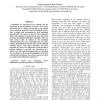Free Online Productivity Tools
i2Speak
i2Symbol
i2OCR
iTex2Img
iWeb2Print
iWeb2Shot
i2Type
iPdf2Split
iPdf2Merge
i2Bopomofo
i2Arabic
i2Style
i2Image
i2PDF
iLatex2Rtf
Sci2ools
IC
2004
2004
A Markup Language for Generic User Interaction
Individuals are interested in the semantic and not necessarily in the presentation of services. The service interaction has to support the quality of the human senses, and since quality of senses is individual, services have to adapt their presentation to each individual automatically. The concept of Generic User Interaction follows this demand by improving the user interaction by means of intelligent adaptation capabilities. The user shall interact with the objects in the individual communication space in a comfortable and easy-to-use manner, independent of location, time, and the available terminal devices. This paper introduces the basic approach of Generic User Interaction, which specifies a markup language to describe user interaction in a generic way. By using this language, the user interface can be adapted to the respective capabilities of the used terminal and according to the current context as well as according to the individual's preferences.
| Added | 31 Oct 2010 |
| Updated | 31 Oct 2010 |
| Type | Conference |
| Year | 2004 |
| Where | IC |
| Authors | Stephan Steglich, Bernd Mrohs |
Comments (0)

